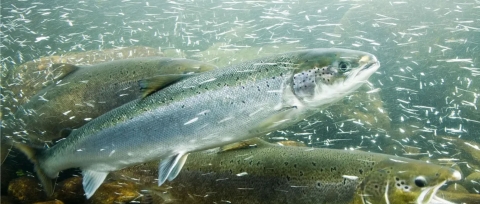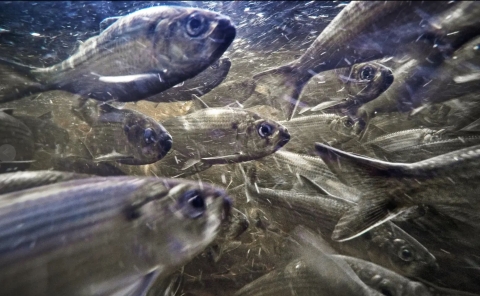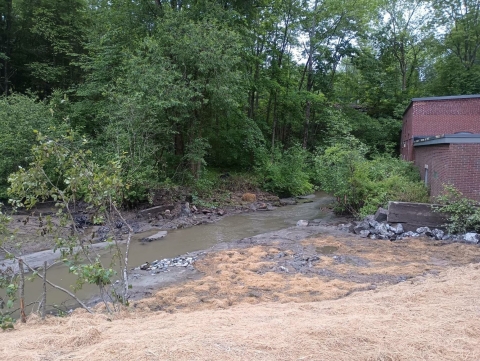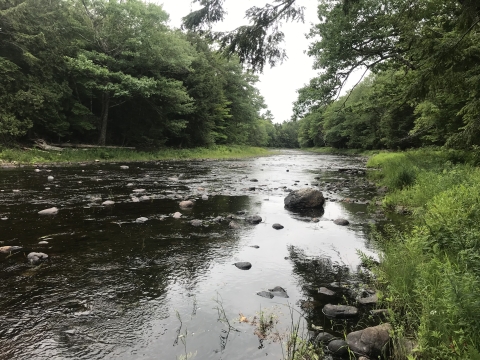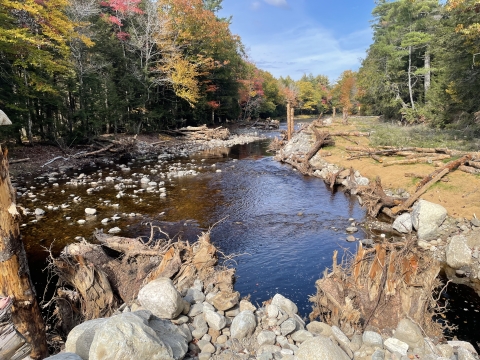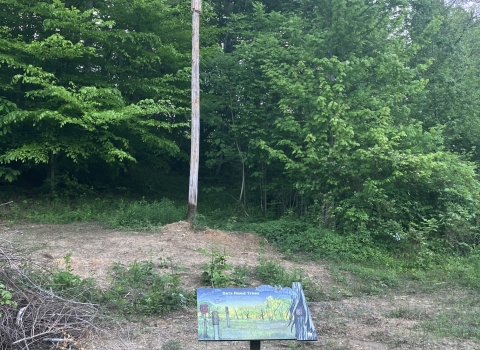World Fish Migration Day is an international celebration that occurs every two years to raise awareness about the importance of migratory fish and the need to protect their migratory routes. The celebration occurs in the spring, coinciding with the peak period of fish migration in many parts of the world.
The theme of this year’s celebration on May 25th, is “Free Flow” which seeks to highlight stories about what free-flowing rivers look like, where they’re located, and why it’s important to have rivers full of fish and other aquatic creatures! The U. S. Fish and Wildlife Service Gulf of Maine Coastal Program supports fish migration and free-flowing rivers by working with communities to remove barriers for fish passage fish passage
Fish passage is the ability of fish or other aquatic species to move freely throughout their life to find food, reproduce, and complete their natural migration cycles. Millions of barriers to fish passage across the country are fragmenting habitat and leading to species declines. The U.S. Fish and Wildlife Service's National Fish Passage Program is working to reconnect watersheds to benefit both wildlife and people.
Learn more about fish passage and restore healthy and connected habitats for the benefit of fish, rivers, and people.
Stream to Sea: The Vital Role of Migratory Fish in Maine’s Ecosystem
Maine's rivers are home to a variety of aquatic species, including both freshwater and diadromous fish. Diadromous fish migrate between freshwater and saltwater environments during their life cycles. These species, including Atlantic salmon, alewife, American shad, and rainbow smelt, rely on continuous water-flow pathways between their spawning, nursery, and feeding grounds in order to survive. Survival of these fish is necessary to regulate food webs, cycle nutrients and energy, and support ecosystem stability.
In addition to ecosystem benefits, there are many other reasons you should care about these fish! They are also integral components of Maine's cultural heritage and economy. Indigenous peoples and early settlers relied on migratory fish species for food, trade, and folklore, and have passed down traditional fishing practices, stories, and values through many generations. Diadromous fish also support commercial and recreational fisheries, contributing to Maine's economy and providing jobs, income, tourism, and economic opportunities for coastal communities and their visitors.
Navigating Obstacles: The Barriers Blocking Maine’s Fish Highways
A variety of obstacles exist in Maine’s rivers, however, which disrupt the migration of these fish and the livelihoods of those who depend on them. These obstacles also impede free-flowing movement of water, nutrients, and sediments. Culverts and bridges typically allow roads and people to safely cross Maine’s vast network of rivers and streams, but many are too small, in poor condition, or clogged. Additional barriers include dams, some of which were once used for hydroelectric power, mill operations, or floating logs downstream for timber harvest. These barriers not only block fish passage and alter natural stream function, but they also raise safety concerns, such as road flooding and erosion.
While physical barriers are a major challenge for fish migration and free flow of Maine rivers, habitat quality is just as important for supporting these migratory fish. Clean, cold, and well-oxygenated waters are vital to many diadromous and freshwater species. Areas of shallow, fast-moving water, in addition to deeper pools, provide necessary habitat complexity. A variety of gravel, cobble, boulders, and large wood in the stream, and vegetation growing along the stream banks, also improves habitat quality. Many of Maine’s rivers lack these habitat qualities due to historical human modifications.
Unblocking the Flow: GOMCP’s Role in Restoring Maine’s Rivers
That’s where we come in! The Gulf of Maine Coastal Program works with partners and communities to remove barriers to enhance aquatic connectivity and habitat quality. Barriers are removed entirely or replaced with improved structures, such as bridges or open-arch culverts that span at least 1.2 times the width of the natural stream. This is one of several criteria that are part of the StreamSmart technical guidance for proper road-stream crossings, which GOMCP supports and enacts in our work. GOMCP and partners also design crossing replacements to allow natural flows through the structure structure
Something temporarily or permanently constructed, built, or placed; and constructed of natural or manufactured parts including, but not limited to, a building, shed, cabin, porch, bridge, walkway, stair steps, sign, landing, platform, dock, rack, fence, telecommunication device, antennae, fish cleaning table, satellite dish/mount, or well head.
Learn more about structure and improve infrastructure resilience to flooding and erosion.
GOMCP and partners restore aquatic connectivity not only through structure removal or upgrade, but also through enhancing habitat quality and reconnecting rivers with their floodplains. This can include adding large wood and boulders to streams, which can provide deep, cool, and protected resting places for fish. Wood and boulders also trap organic matter that supports the aquatic insects fish forage for. Other techniques include reconnecting side channels and excavating pools to increase cool groundwater inputs. Constructing properly sloped and vegetated stream banks and floodplains also supports overall habitat stability and quality.
Success Stories: Highlighting GOMCP’s Restoration Projects
One example of GOMCP’s work to establish healthy and free-flowing rivers is the removal of three dams and re-opening of three miles of stream on Frost Gully Brook in Freeport, Maine, in 2023. The dams were once used for drinking water supply and fire protection but no longer served that purpose. Their removal unlocked high-quality habitat for native, recreational, and commercially important fish, including Eastern brook trout. Returning the brook to its natural free-flowing state also decreases water temperatures and improves nutrient flow and water quality. Other habitat improvements included invasive plant removal and native species plantings, which will be monitored in subsequent years, with adaptive management, if necessary. This project was completed through a diverse partnership between GOMCP, Freeport Conservation Trust, Trout Unlimited, Maine Water Company, Casco Bay Estuary Partnership, and others.
In-stream habitat restoration is an important focus of GOMCP’s work to improve passage and overall habitat quality for fish and aquatic organisms. A restoration project in the Narraguagus River was completed in spring 2023, which included construction of three engineered log jams, a new floodplain to narrow the river, placement of large wood and boulders in the river, and reconnection of two historical side channels with substantial groundwater input. While this project included no removal of physical stream barriers such as dams or culverts, these actions restored natural processes and increased fish refuge, which had been lost by historical log drives that over-widened, shallowed, and simplified the river.
Swimming Forward: The Future of Fish Migration and River Health in Maine
GOMCP has also been a leader in the launch of the new Maine Riverscape Restoration Network, which is a collaborative group dedicated to voluntary in-stream and holistic restoration of riverine habitat for native species in Maine. Overall, GOMCP and partners aim to address aquatic habitat impairments and establish connected, structurally complex, and dynamic ecosystems that are self-sustaining.
For World Fish Migration Day, the Gulf of Maine Coastal Program shares and celebrates the successes of these projects and initiatives for the benefit of native fish and other aquatic species. GOMCP looks forward to working with a diverse set of partners on future projects to support free-flowing rivers full of fish in Maine and celebrate the purpose of World Fish Migration Day for years to come. We hope these stories highlight the importance of conserving and stewarding Maine’s iconic migratory species and their habitats for present and future generations.
